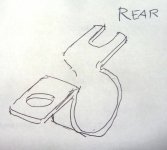Bob_Spidell
Yoda
Offline
While getting ready to drop the rebuilt engine into my BJ8, I noticed the 'throttle relay shaft'--yeah, the one under the scuttle, all but impossible to get to with the engine installed--was bent. 'Crap,' I thought, 'one more job to do before I can get the engine in.' It turns out this was serendipitous--first time this word's been used on the Forum?--because as I inspected the shaft, I noticed that one of the two brackets was also bent, and further inspection revealed that the bush on the driver's side was way sloppy (actually, pretty much gone). A quick check of the Moss catalog showed 'N/A' for all the parts--I'm screwed, I thought. Then, I remembered I'd bought a replacement set--supposedly made of teflon, but they say 'nylon' on the bag--but had given up on installing them because the instructions showed 'through BN7 and BT7' (BJ7/8s need not apply). I called BCS to see what they had, and John, their parts guy said they'd work on BJ8s. So, I did some digging and, although the photo of the instructions and applications on Moss' web page showed 'though BN7 and BT7,' if you download the instructions--5 pages!--they've been revised to show they work on the 'J' cars.
Anyway, if anyone has the engine out of one of the later 6-cyl cars I recommend you check these brackets and bushings. They are bronze bonded to rubber and, although my car has nearly 200K miles, I suspect the life of these is determined as much/more in years as in miles, as the rubber gets baked by engine heat. The rubber on my driver's side bush was completely dry, caked and brittle, and could conceivably have resulted in a stuck throttle. The instructions are intimidating--5 pages!--but, except for having to work under the dash, which I hate, the job was pretty straightforward. I managed to get the shaft reasonably straight, and the used bracket I got from BCS was in good shape (though, in hindsight, I probably could have straightened my bent one), so now my Rube Goldberg-designed throttle works smooth and with no slop.
Thought I'd pass this along since I hadn't seen this issue discussed before. I'd long since replaced the rubber/bronze bush on the shaft on the engine, and should never have to worry about these again. Credit to to Eric Gruden who designed these bushes, and to Moss for going the extra mile to provide these, for a reasonable cost (about $13).
Anyway, if anyone has the engine out of one of the later 6-cyl cars I recommend you check these brackets and bushings. They are bronze bonded to rubber and, although my car has nearly 200K miles, I suspect the life of these is determined as much/more in years as in miles, as the rubber gets baked by engine heat. The rubber on my driver's side bush was completely dry, caked and brittle, and could conceivably have resulted in a stuck throttle. The instructions are intimidating--5 pages!--but, except for having to work under the dash, which I hate, the job was pretty straightforward. I managed to get the shaft reasonably straight, and the used bracket I got from BCS was in good shape (though, in hindsight, I probably could have straightened my bent one), so now my Rube Goldberg-designed throttle works smooth and with no slop.
Thought I'd pass this along since I hadn't seen this issue discussed before. I'd long since replaced the rubber/bronze bush on the shaft on the engine, and should never have to worry about these again. Credit to to Eric Gruden who designed these bushes, and to Moss for going the extra mile to provide these, for a reasonable cost (about $13).

 Hi Guest!
Hi Guest!

 smilie in place of the real @
smilie in place of the real @
 Pretty Please - add it to our Events forum(s) and add to the calendar! >>
Pretty Please - add it to our Events forum(s) and add to the calendar! >> 

